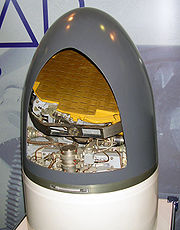
Kh-35
Encyclopedia


The Zvezda Kh-35U is the jet-launched version of a Russia
Russia
Russia or , officially known as both Russia and the Russian Federation , is a country in northern Eurasia. It is a federal semi-presidential republic, comprising 83 federal subjects...
n subsonic anti-ship missile
Anti-ship missile
Anti-ship missiles are guided missiles that are designed for use against ships and large boats. Most anti-ship missiles are of the sea-skimming type, many use a combination of inertial guidance and radar homing...
. The same missile can also be launched from helicopters, surface ships and coastal defence batteries with the help of a rocket booster, in which case it is known as Uran ('uranium';SS-N-25 'Switchblade'; GRAU
Grau
Grau is a German word meaning "gray" and a Catalan word meaning "grade". It may refer to:* BAP Almirante Grau , a De Zeven Provinciën class cruiser in service with the Peruvian Navy* Grau Käse, Tyrolean grey cheese...
3M24) or Bal ('whale';SSC-6 'Stooge';GRAU 3K60). It is also nicknamed Harpoonski for its similarity to the AGM-84 Boeing Harpoon
Boeing Harpoon
The Harpoon is an all-weather, over-the-horizon, anti-ship missile system, developed and manufactured by McDonnell Douglas . In 2004, Boeing delivered the 7,000th Harpoon unit since the weapon's introduction in 1977...
. It is designed to attack vessels up to 5000 tonnes.
Development
Zvezda started work on the Kh-35 in 1983 as a surface-to-surface missile to replace the SS-N-2 'Styx' for export markets.Design
The Kh-35 missile is a subsonic weapon featuring a normal aerodynamic configuration with cruciform wings and fins and a semisubmerged air duct intake. The propulsion unit is a turbofanTurbofan
The turbofan is a type of airbreathing jet engine that is widely used for aircraft propulsion. A turbofan combines two types of engines, the turbo portion which is a conventional gas turbine engine, and the fan, a propeller-like ducted fan...
engine. The missile is guided to its target at the final leg of the trajectory by commands fed from the active radar homing head and the radio altimeter.
Target designation data can be introduced into the missile from the launch aircraft or external sources. Flight mission data is inserted into the missile control system after input of target coordinates.
An inertial system controls the missile in flight, stabilizes it at an assigned altitude and brings it to a target location area. At a certain target range, the homing head is switched on to search for, lock on and track the target.
The inertial control system then turns the missile toward the target and changes its flight altitude to an extremely low one. At this altitude, the missile continues the process of homing by the data fed from the homing head and the inertial control system until a hit is obtained.
A new radar seeker, Gran-KE have been developed by SPE Radar MMS and will be replacing the existing ARGS-35E X band seeker.
Variants
- Kh-35U (AS-20 'Kayak', Article 78U) - launched from fast jets.
- Kh-35E Uran (SS-N-25 'Switchblade', 3M24) - launched from helicopters, coastal defence batteries, and ships such as the Neustrashimy frigatesNeustrashimy Class frigateNeustrashimy class frigates are the most modern large frigates in the Russian Navy. The Soviet designation is Project 1154 Yastreb .-Design:...
, Tartarstan/Gepard frigatesTartarstan/Gepard class frigateThe Gepard class frigates were intended as a successor to the earlier Koni, Grisha, and Parchim-class corvettes. The first unit of the class, Yastreb , was laid down at the Zelenodol'sk Zavod shipyard at Tatarstan in 1991. It was launched in July 1993, after which it began fitting out...
and as upgrades to two Krivak frigateKrivak class frigateThe Project 1135 Burevestnik class were a series of frigates built for the Soviet Navy. These ship are commonly known by their NATO reporting name of Krivak and are divided into Krivak-I, Krivak-II, and Krivak-III classes.These ships were designed as a successor to the Riga class...
. It comes in a containerised launcher with four missiles. - 3M24M Bal (SSC-6 'Stooge') - coastal defence version, very similar to the Kh-35E
- IC-35 - target drone
- Kh-35UE - upgrade with a smaller engine allowing increased fuel capacity, and increased range.
- Kh-37 (3M24E1) - proposed upgrade with 250 km range and a land-attack capability, GPS mid-course guidance and an imaging infrared seeker akin to the Standoff Land Attack MissileStandoff Land Attack MissileThe Standoff Land Attack Missile or SLAM is a subsonic, over-the-horizon, all-weather standoff cruise missile which grew out of the United States Navy's Harpoon anti-ship missile in the 1970s.-Original SLAM:...
(SLAM). Some sources attribute the name Uran or Bal to this variant
Current operators
Similar weapons
- Boeing HarpoonBoeing HarpoonThe Harpoon is an all-weather, over-the-horizon, anti-ship missile system, developed and manufactured by McDonnell Douglas . In 2004, Boeing delivered the 7,000th Harpoon unit since the weapon's introduction in 1977...
(USA) - 221 kg warhead, 93–315 km range depending on platform - C-802C-802The Yingji-82 or YJ-82 is a Chinese anti-ship missile first unveiled in 1989 by the China Haiying Electro-Mechanical Technology Academy , also known as the Third Academy...
/YJ-82 CSS-N-8 'Saccade' (China) - 165 kg warhead, 120–180 km km range - ExocetExocetThe Exocet is a French-built anti-ship missile whose various versions can be launched from surface vessels, submarines, helicopters and fixed wing aircraft. Hundreds were fired in combat during the 1980s.-Etymology:...
(France) - 165 kg warhead, 70–180 km range - RBS-15 (Sweden) - 200 kg warhead, 200 km range
- Sea Eagle (UK) - 230 kg warhead, 110+ km range

